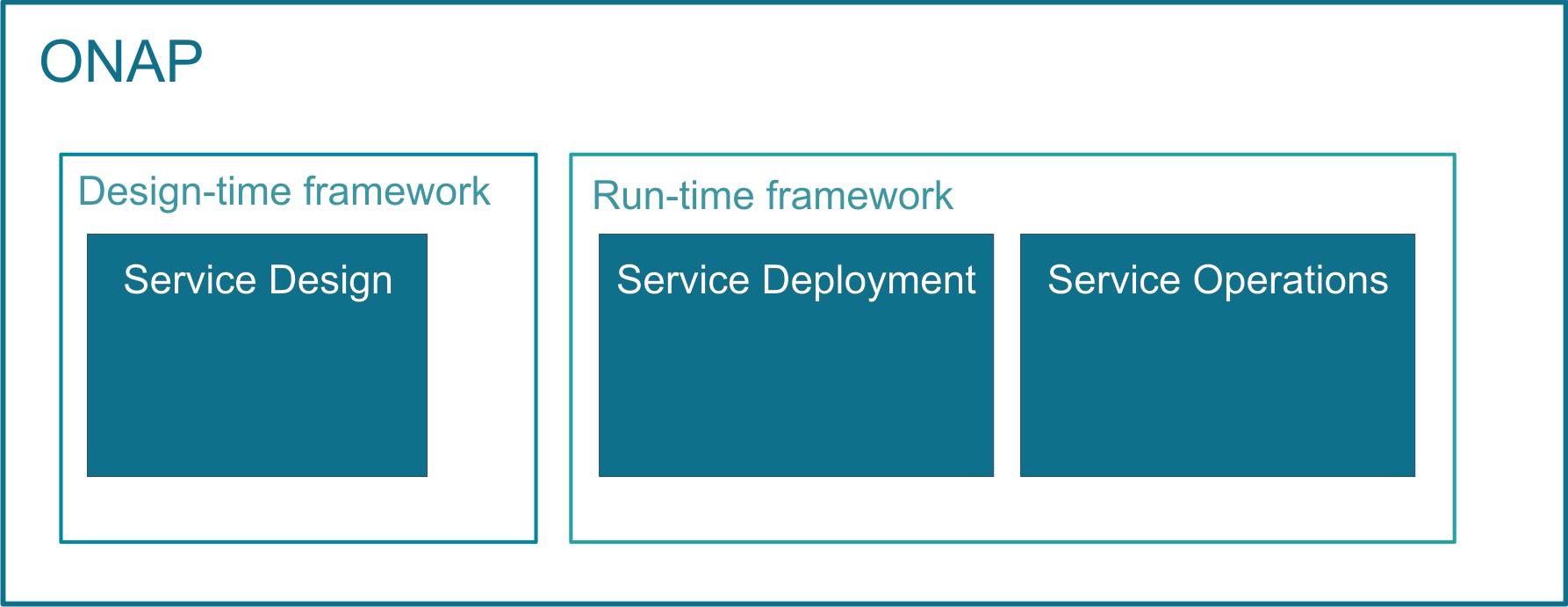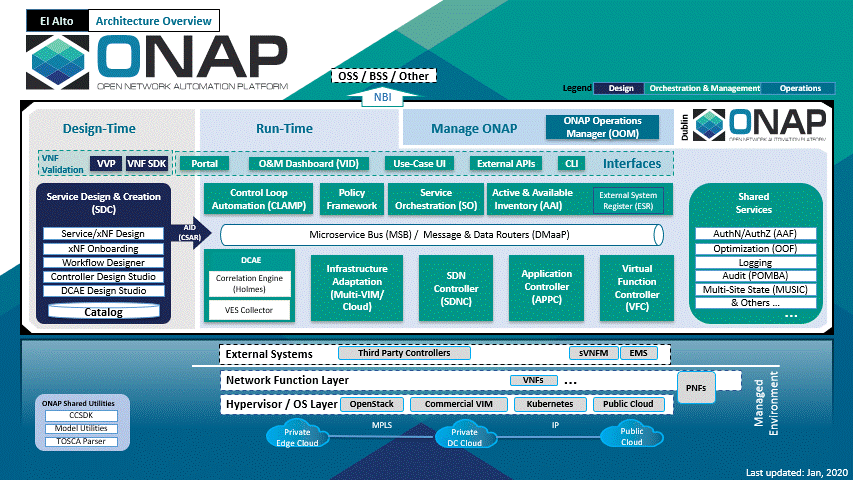...
ONAP’s major activities, that is designing, deploying and operating services, are provided based on ONAP’s two major frameworks, namely on Design-time framework and Run-time framework:
In order to design, deploy and operate services and assure these dynamic services, ONAP activities are built up as follows:
- Service design – Service design is built on a robust design framework that allows specification of the service in all aspects – modeling the resources and relationships that make up the service, specifying the policy rules that guide the service behavior, specifying the applications, analytic and closed control loop events needed for the elastic management of the service.
- Service deployment – Service deployment is built on an orchestration and control framework that is policy-driven (Service Orchestrator and Controllers) to provide automated instantiation of the service when needed and managing service demands in an elastic manner.
- Service operations – Service operations are built on an analytic framework that closely monitors the service behavior during the service lifecycle based on the specified design, analytics and policies to enable response as required from the control framework, to deal with situations ranging from those that require healing to those that require scaling of the resources to elastically adjust to demand variations.
ONAP enables product- or service-independent capabilities for design, deployment and operation, in accordance with the following foundational principles:
- Ability to dynamically introduce full service lifecycle orchestration (design, provisioning and operation) and service API for new services and technologies without the need for new platform software releases or without affecting operations for the existing services
- Carrier-grade scalability including horizontal scaling (linear scale-out) and distribution to support large number of services and large networks
- Metadata-driven and policy-driven architecture to ensure flexible and automated ways in which capabilities are used and delivered
- The architecture shall enable sourcing best-in-class components
- Common capabilities are ‘developed’ once and ‘used’ many times
- Core capabilities shall support many diverse services and infrastructures
- The architecture shall support elastic scaling as needs grow or shrink
ONAP Functional Architecture
The above diagram shows the main ONAP activities in a chronological order.
Service design - ONAP supports Service Design operations, using the TOSCA approach. These service design activities are built up of the following subtasks:
- Planning VNF onboarding – checking which VNFs will be necessary for the required environment and features
- Creating resources, composing services
- Distributing services - Distributing services constitutes of 2 subtasks:
- TOSCA C-SAR package is stored in the Catalog * new service notification is published
Service orchestration and deployment
- Defining which VNFs are necessary for the service
- Defining orchestration steps
- Selecting valid cloud region
- Service orchestration calling cloud APIs to deploy VNFs
- The onboarding and instantiation of VNFs in ONAP is represented via the example of onboarding and instantiating a virtual network function (VNF), the virtual Firewall (vFirewall). Following the guidelines and steps of this example, any other VNF can be similarly onboarded and instantiated to ONAP. See virtual Firewall Onboarding and Instantiating examples.
- Controllers applying configuration on VNFs
Service operations
- Closed Loop design and deployment
- Collecting and evaluating event data
Benefits of ONAP
Open Network Automation Platform provides the following benefits:
- common automation platform, which enables common management of services and connectivity, while the applications run separately
- a unified operating framework for vendor-agnostic, policy-driven service design, implementation, analytics and lifecycle management for large-scale workloads and services
- orchestration for both virtual and physical network functions
- ONAP offers Service or VNF Configuration capability, in contrast to other open-source orchestration platforms
- the model-driven approach enables ONAP to support services, that are using different VNFs, as a common service block
- service modelling enables operators to use the same deployment and management mechanisms, beside also using the same platform
ONAP Releases
ONAP is enhanced with numerous features from release to release. Each release is named after a city.
| Release Name | Release version | Release Date | Features delivered |
|---|---|---|---|
| El Alto | 5.0.1 | 24 October 2019 | El Alto Release Notes |
| Dublin | 4.0.0 | 9 July 2019 | |
| Casablanca |
|
| |
| Beijing | 2.0.0 | 7 June 2018 | |
| Amsterdam | 1.0.0 | 16 November 2017 |
3.3 OpenDaylight
Editor: Abhijit Kumbhare
...

